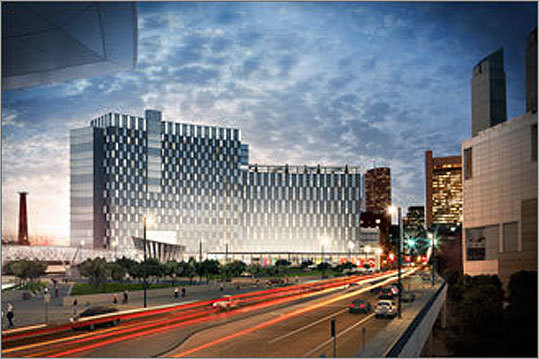Have We Got a Convention Center to Sell You!
From Boston to Austin, politicians spend money on fancy white elephants.
December 31, 2011
By STEVEN MALANGA
For two decades, America's convention center business has been declining, resulting in a nationwide surplus of empty meeting facilities, struggling convention halls and vacant hotel rooms. How have governments responded to this glut? By building more convention centers, of course, financed by debt backed by new taxes and fees on already struggling taxpayers.
Back in 2007, before the recession began, a report from Destination Marketing Association International described America's convention industry as a "buyer's market" suffering excess capacity. It's only gotten worse, attracting just 86 million attendees in 2010, compared to 126 million in 2000. Meanwhile, the amount of convention space angling for business has increased to 70 million square feet, up from 53 million in 2000 and 40 million two decades ago.
That's largely because governments refuse to stop making convention centers bigger and hotels even more dazzling, arguing that whatever business remains will flow to the places with the fanciest amenities. To finance these risky projects—which the private sector won't build by itself—cities float debt backed by new taxes and fees on already struggling taxpayers. As Charles Chieppo, a former board member of Massachusetts Convention Center Authority, lamented last year, "Logic rarely has a place in the convention business."
Take Illinois, an industry leader,where officials have invested heavily to keep Chicago's McCormick Place, long one of the three most-used centers in the nation, on top. They spent $1 billion in the early 1990s to build a 840,000-square foot expansion financed by fees on auto rentals, a hotel tax and a surcharge on restaurant meals in downtown Chicago. In 2007 they opened a new building, McCormick West, at a cost of an additional $900 million. The result? According to the Chicago Tribune, the center operates at 55% capacity.
Then there's Boston, perhaps the quintessential example of a city that interprets failure in the convention business as a license to spend more on it. Massachusetts officials shelled out $230 million to renovate Hynes Convention Center in the late 1980s. When the makeover produced virtually no economic bounce, officials decided that the city needed a new, $800 million center financed by a hotel occupancy excise tax, a rental-car surcharge, and the sale of taxi medallions. Opened in 2004, that new Boston Convention and Exhibition Center was projected (by consultants hired by the state) to have Boston renting some 670,000 additional hotel rooms annually within five years. Instead, Beantown saw just 310,000 additional hotel room rentals in 2009.
Now Massachusetts officials want to spend $2 billion to double the size of the Boston Convention Center and add a hotel. Of course, they predict that the expanded facilities would bring an additional $222 million into the local economy each year, including 140,000 hotel room rentals. Even with these bullish projections, officials claim that the hotel would need $200 million in public subsidies.
"The whole thing is a racket," Boston Globe columnist Jeff Jacoby recently observed. "Once again the politicos will expand their empire. Once again crony capitalism will enrich a handful of wired business operators. And once again Joe and Jane Taxpayer will pay through the nose. How many times must we see this movie before we finally shut it off?"
Many times, if officials in Baltimore have their way. Several years ago they built a $300 million city-owned hotel, (the Hilton Baltimore Convention Center Hotel) to boost the fortunes of the city's struggling convention center. Having opened in 2008, the hotel lost $11 million last year. Now the city is considering a public-private expansion plan that would add a downtown arena, an additional convention hotel, and 400,000 feet of new convention space at the cost of $400 million in public money.
The list goes on—everywhere from Columbus, Ohio, to Dallas, Austin, Phoenix and places in between. One problem is that optimistic projections about new facilities fail to account for how other cities are expanding, too. Why did Minneapolis struggle to hit projected targets after it enlarged its convention center in 2002? "Other cities expanded right along with us,'' Minneapolis's convention center director, Jeff Johnson, said this year.
The surest sign that taxpayers should be leery of such public investments is that officials have changed their sales pitch. Convention and meeting centers shouldn't be judged, they now say, by how many hotel rooms, restaurants, and local attractions they help fill. That's "narrow-minded thinking," said James Rooney of the Massachusetts Convention Center Authority this year. Instead, as Boston Mayor Thomas Menino has said, expanding a convention center can "demonstrate to the world that we have unlimited confidence in our city and what it can do, not only as a convention destination but as the center of the most important trends in hospitality, science, health and education."
This new metric—a city's amorphous brand value—is little more than a convenient way to ignore the failure of publicly sponsored facilities to live up to exaggerated projections. But as far as city officials are concerned, that failure is nothing that hundreds of millions more in taxpayer dollars can't fix.
Mr. Malanga is a senior editor at City Journal. A longer version of this article appears in City Journal's Winter 2012 issue.



